DETERMINING THE RIDER'S SEAT SIZE
|
||||||||||||||||||||||||||||||||||||||||
The rider’s seat size can effect saddle fit. If the seat size is to big or to small, the rider’s weight will not be distributed evenly and could result in a decreased level of saddle fit. How one determines seat size depends upon who one talks to. There is an old saying: “Ask 10 horseman the same question and you will get 11 different answers”. Here is a sampling of “rules of thumb.”
|
||||||||||||||||||||||||||||||||||||||||
“There should be approximately four inches between the front of your body and the fork (or swells). Your rump should rest on the base of the cantle, but should not be pressed against the back of the cantle. Some prefer a tighter fit, some looser. In general, it's better to have a saddle a smidge too big than a smidge too small.”
|
||||||||||||||||||||||||||||||||||||||||
“Your Seat Size
To determine your seat size, sit in the saddle and see whether you have approximately a two-finger distance between the front swell and your leg. This is a good rule of thumb for trail and pleasure riding. Ropers and barrel racers might want to feel more secure, so a one-finger distance would work. Show saddles have center pocket seats and put the rider in the proper position in the saddle so the two-finger rule is not that important. Just make sure it feels comfortable.”
|
||||||||||||||||||||||||||||||||||||||||
“A western saddle will give you 4 inches in front, but your backside needs to rest against the base of the cantle, and not feel squashed up against it.”
|
||||||||||||||||||||||||||||||||||||||||
“Here's how to measure for the proper saddle seat size: When sitting comfortably in your saddle, with your feet in the stirrups and the stirrups adjusted properly, you should have half of an inch between the front of your thigh and the saddle swells.”
|
||||||||||||||||||||||||||||||||||||||||
“You should be able to place three fingers width behind and in front of your seat when you are in the saddle.”
|
||||||||||||||||||||||||||||||||||||||||
“The late John Piland told me to sit in the saddle with my horn arm close by my side, my elbow at a right angle and that I should be able to grasp the horn without reaching down and forward. I have used that guide as I have had my saddles built.”
|
||||||||||||||||||||||||||||||||||||||||
“For a western saddle, you should have about a hand's breadth (4 inches) in front of you and about a hand's width (1-1.5 inches) behind you to the cantle.”
|
||||||||||||||||||||||||||||||||||||||||
So pick your poison.
|
||||||||||||||||||||||||||||||||||||||||
Also, there are charts and tables that use the rider’s height and weight to determine seat size.
In reviewing these charts it is ASMA’s opinion that they tend to be inaccurate and misleading and should not be relied upon.
|
||||||||||||||||||||||||||||||||||||||||
A better way is with the rider sitting the saddle: their seat resting comfortably against the cantle, their feet under them in the traditional straight line from the shoulder - hip - heel position (see FIGURE 1) stand up in the stirrups without using the horn. The rider should have no problem standing up without any assistance if centered. If the seat is to small, the rider will tilt forward (see FIGURE 2). If the seat is to large, the rider will be forced back into the cantle(see FIGURE 3) .
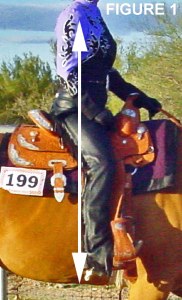 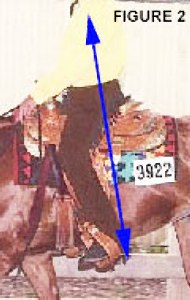 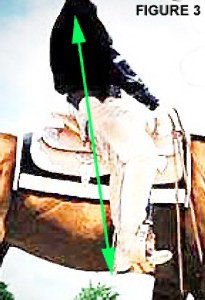 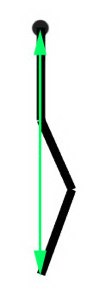 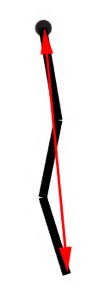 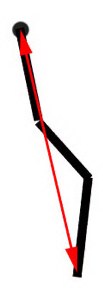 These results are caused by the stirrup leathers. As stirrup leathers pass over the bars of the tree they act as a pivot point. If the center of the rider is forward of the pivot point the riders torso will tilt forward and the feet and legs will move backwards.
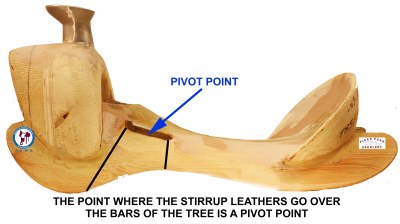 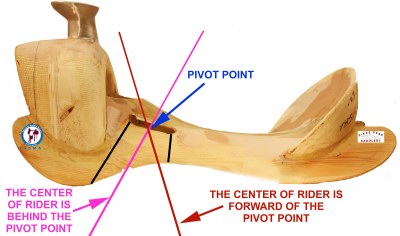 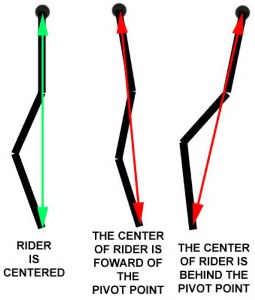 If the rider’s center is back of the pivot point the rider’s feet and legs will move forward and the rider’s seat will be forced into the cantle.
Therefore, technically, if the rider is sitting in the saddle with their seat resting comfortably against the cantle and can stand up in the stirrups without assistance the seat size is correct.
The rider needs a seat that is also comfortable. The seat size may be correct but if it is not comfortable for the rider, the result is a negative fit. It the responsibility of the saddle maker to design, build, and shape the seat where the rider is both comfortable and centered.
It has be observed that riders have a tendency to ride a saddle with a larger seat. The reason for this is unclear, but there are indicators. Some of the “rules of thumb” and charts will result in a larger seat than is correct for the rider. Some riders prefer their feet and legs out in front as if they were sitting in a chair. Others feel more secure when pivot effect pushes them back into the cantle and they are braced in the saddle.
The final decision is up to the rider with the understanding that and if the seat size selected is to small or to large for the rider the level of positive saddle fit may be decreased.
|
||||||||||||||||||||||||||||||||||||||||
e-mail mailto:info@saddlemakers.org
Copyright 2005 - 2016 American Saddle Makers Association, Inc.
